- May 26, 2014
Ravioli is my kind of food. Playful, utilitarian, delicious......The key to great homemade gluten free ravioli is the dough! No wait, the filling! Lemme think, the sauce! No, that's not quite right. It is the proportion between all three! Truly, balance is key here. If the dough is rolled too thickly, then when it get sandwiched together it overwhelms the filling. If you put too much filling in, you ain't never going get that sucker to seal. If it doesn't come apart right then and there, it certainly will fall apart will when you boil it. And the sauce, well it should compliment, enhance, elevate; not just drown the poor dears. There are a few keys steps to ensure the process is easy and the ravioli making successful.
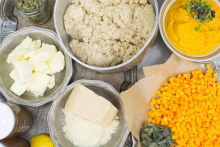 1. Select Your Filling
1. Select Your Filling
Really, anything goes here. I have only one rule, make sure whatever goes in the filling is either cooked or can be cooked within the 4-5 minute boiling time it takes to cook the fresh pasta. Also, avoid "sharp" or "pointy" things that may poke through the thin gluten free pasta dough. Ok, so two rules. Your filling can be made days in advance, can be leftovers from the fridge, or can be something simple and store-bought.
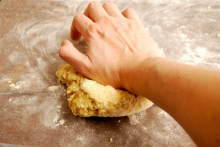 2. Make Your Dough
2. Make Your Dough
Because no one can tell in advance how much gluten free flour will ultimately be used in making the dough, the sensible method is to make pasta dough by hand. This allows you to incorporate the perfect amount of flour as you work the dough together. If you insist upon using a machine, put the wet ingredients in the mixing bowl and slowly add the flour, stopping often to check the texture with your hands. For stuffed pastas, it is better to have a slightly stickier dough since this will help the two sheets attach together. Check out our recipe using Cheatin' Wheat Gluten Free Flour.
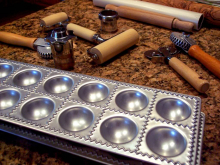 3. Assemble Ravioli
3. Assemble Ravioli
First, find a smooth, flat surface with enough space to work comfortably - even if this means using your dining room table. Before you ever grab the rolling pin, set up your work area and production line in advance. This should include your filling, gluten free pasta dough, gluten free dusting flour, all cutters and tools, a sheet pan lined with parchment paper to take the finished ravioli, etc. Also, it is important to keep the gluten free pasta dough from drying out as you work. Always work with manageable-sized pieces and keep any other dough wrapped or covered.
Using plenty of sweet rice flour as dusting flour, roll out some of the pasta dough into two very thin sheets. One sheet will be the bottom half of the ravioli, and another sheet will be the top. Premark, but do not cut through, the bottom sheet of pasta using a round cookie cutter. This helps you visualize how much filling can go in each ravioli. You can use a small ice cream scoop or a pastry bag to place filling in the 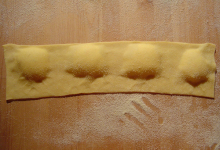 center of the pre-marked circles. Gently lay the top sheet of pasta over the layer covered with filling. Work out any air bubbles by gently but firmly pushing the air from the edge of the filling to the edge of the pasta with your fingers. Continue pushing the air out until there is no more air trapped in the ravioli. This trapped air will expand during cooking and can cause the ravioli to burst. Your goal is to seal each pocket without tearing the dough. Cut out the individual ravioli and the check the seal by pinching all the edges.
center of the pre-marked circles. Gently lay the top sheet of pasta over the layer covered with filling. Work out any air bubbles by gently but firmly pushing the air from the edge of the filling to the edge of the pasta with your fingers. Continue pushing the air out until there is no more air trapped in the ravioli. This trapped air will expand during cooking and can cause the ravioli to burst. Your goal is to seal each pocket without tearing the dough. Cut out the individual ravioli and the check the seal by pinching all the edges.
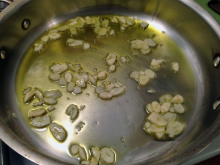 4. Make Your Sauce
4. Make Your Sauce
Or heat-up your sauce. If it is something simple like garlic, olive oil and fresh grated cheese, get all of those prepped. The sauce should be waiting on the ravioli, not the other way around. Fresh pasta takes mere minutes to cook. If your sauce is not ready before you drop them in the water, it won't be ready.
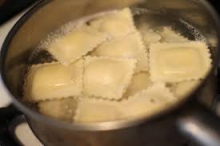 5. Cook Ravioli
5. Cook Ravioli
Lots. Of. Boiling. Salted. Water. Ok, here are some guidelines. At least four quarts of water are required for a pound of pasta. Never cook more then two pounds at once. Use at least 1 1/2 tablespoons of salt for every pound of pasta. Use a slotted spoon to remove the ravioli instead of pouring into a colander and losing all that great pasta water.
6. Flavors for Thought
Because we like to keep it interesting, here are some flavor combinations that sound super yummy right now:
- Lemon Ricotta with Sage & Brown Butter
- Duxelle with Roasted Garlic, Balsamic & Parmesan
- Lobster with Vanilla Scented Cream Sauce
- Beef with Marinara
- Squash with Sage, Walnuts and Brown Butter
- Egg Yolk with Saffron Tomato Broth





 Find our products
Find our products FAQs
FAQs Testimonials
Testimonials R&D Projects
R&D Projects